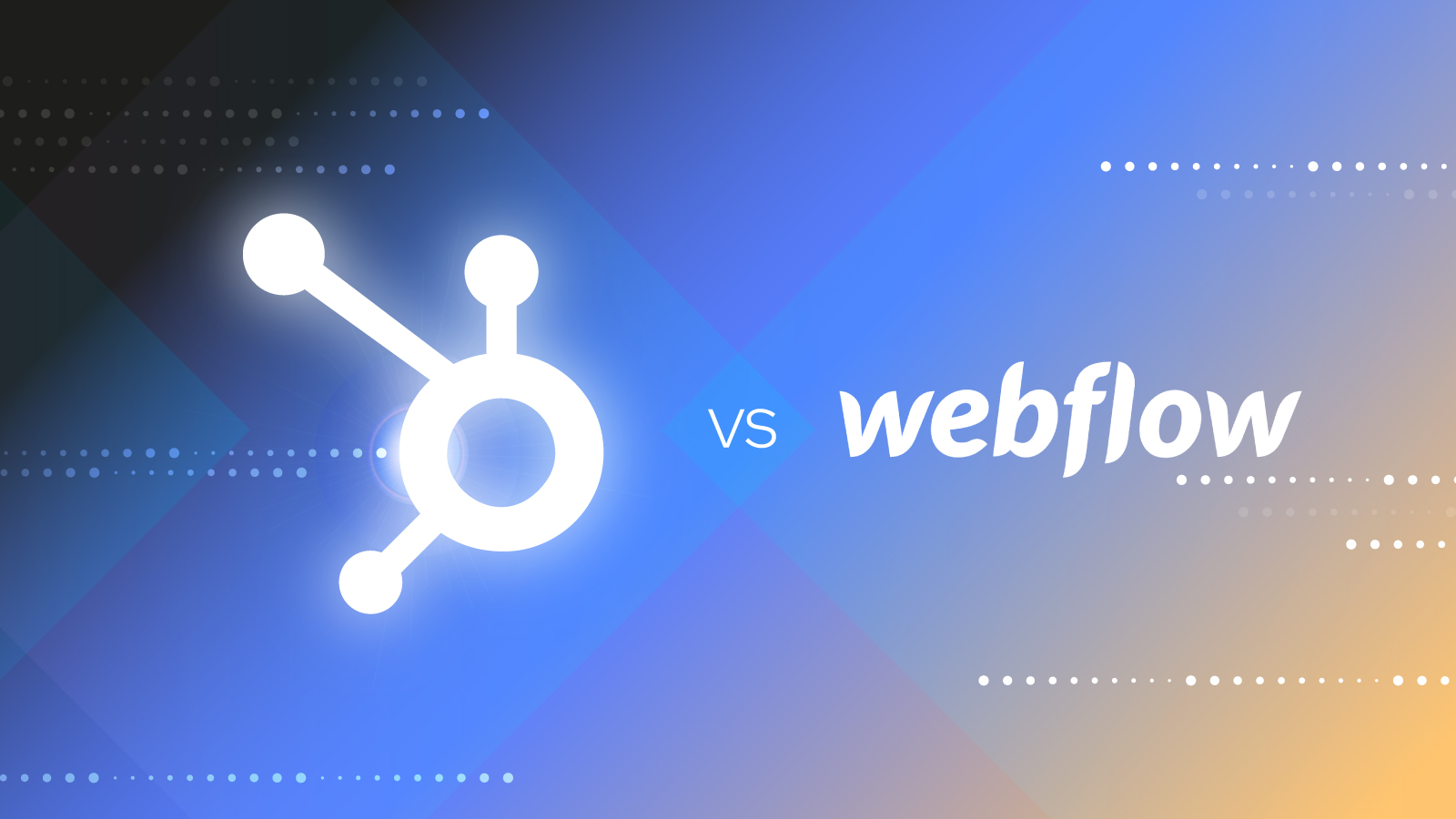Are you looking for the perfect platform to build your website or manage your marketing campaigns? With so many options out there, it can be overwhelming to choose the right one for your business.
Two popular platforms that often come up in this conversation are HubSpot and Webflow.
HubSpot is a comprehensive inbound marketing and sales platform that provides a range of tools for businesses to attract, engage, and delight their customers. On the other hand, Webflow is a website builder and content management system (CMS) that allows users to design and build responsive websites without any coding experience.
Both platforms have their strengths and weaknesses, and choosing the right one depends on your business needs and goals.
What is Webflow
Introduced to the world in 2013, Webflow has emerged as a game-changing platform that empowers individuals to create stunning websites without the need for coding expertise. With its intuitive visual website editor, Webflow enables users to design and construct custom pages and templates effortlessly. Serving as a content management system, Webflow goes beyond mere web design by offering an optional package to integrate e-commerce functionalities seamlessly through its Webflow E-commerce plan.
What is HubSpot
HubSpot CMS Hub is a cloud-based content management system built on top of HubSpot CRM. This powerful combination offers users a comprehensive solution for managing their website content and customer relationships in one centralised hub.
One of the standout features of HubSpot CMS Hub is its user-friendly drag-and-drop website builder, empowering individuals with diverse technical backgrounds to create captivating custom pages and templates without the need for extensive coding knowledge. Whether you're aiming to design an eye-catching homepage, launch a compelling landing page, or publish engaging blog posts, HubSpot CMS Hub provides the tools to bring your vision to life.
But the capabilities of HubSpot CMS Hub extend beyond website design. It serves as an all-in-one tool for managing various aspects of your online presence. With integrated media management, you can effortlessly organise and optimise your media assets, ensuring a seamless visual experience for your visitors.
In addition, HubSpot CMS Hub integrates closely with HubSpot's marketing, sales, and operations tools, creating a unified ecosystem that streamlines your entire business operation. You can leverage powerful marketing automation features, lead capture forms, and lead nurturing campaigns to drive conversions and foster customer engagement. Furthermore, comprehensive website analytics and SEO tools allow you to monitor your website's performance, gain insights into visitor behaviour, and optimise your content for search engines
Advantages of Webflow
Webflow is a powerful and accessible platform that offers numerous advantages for users of all skill levels. Let's delve into some of its key strengths:
- Design autonomy: Webflow empowers website owners with robust designer and editor tools, eliminating the need for external assistance in managing website design and content. The platform's intuitive interface enables users to take full control and make real-time updates, giving them the autonomy to shape their websites according to their preferences.
- Engaging pages: With Webflow CMS, users can create captivating and interactive content on their websites. The platform supports the creation of dynamic content, including interactions and scroll-based parallax animations, which enhance the user experience. Additionally, the ability to generate data-driven pages allows for personalised content tailored to the needs and interests of visitors.
- Top-notch support: Webflow prides itself on providing world-class support to its users. Whether it's assistance with CMS usage or e-commerce integration, the Webflow team is readily available to offer guidance and resolve any issues that may arise. This reliable support system ensures a smooth and successful website-building experience.
- Template marketplace: Webflow provides a diverse marketplace of pre-built templates, allowing users to quickly get their websites up and running. These templates can be easily customised without the need for coding, giving creators the freedom to tailor the designs according to their specific requirements and branding.
- Staging environment: Webflow recognizes the importance of staging environments for seamless and functional websites. The platform offers a staging feature, providing users with a separate environment to make changes and modifications before publishing them to the live website. This ensures that websites maintain their quality and functionality during the development process.
- Codeless platform: Webflow exemplifies a no-code platform, enabling users to design, build, and launch responsive websites without the need to write any code. Its robust designing and editing tools eliminate the reliance on external assistance, allowing individuals to create professional websites independently.
Advantages of HubSpot
HubSpot CMS offers several distinct advantages over Webflow. Let's explore some of these key strengths:
- Comprehensive analytics: Unlike Webflow, HubSpot CMS provides powerful out-of-the-box analytics capabilities. Marketers using HubSpot gain a comprehensive view of user interactions with their website. The platform offers detailed insights into website traffic by topic cluster, country, acquisition source, and more. These analytics enable marketers to make data-driven decisions and optimise their strategies effectively.
- CRM and marketing tools: HubSpot CMS includes built-in customer relationship management (CRM) and a suite of marketing tools. This integration allows businesses to streamline their sales and marketing efforts within a single platform. HubSpot's CRM and marketing tools provide a cohesive solution for managing customer data, executing targeted campaigns, and driving conversions.
- Native membership feature: With HubSpot, users have access to a native membership feature that enables the creation of gated content for members. This functionality allows businesses to offer incentives to customers who sign up or subscribe, enhancing engagement and customer loyalty. Webflow, on the other hand, does not have a native membership feature, although it may introduce one in the future.
- Greater control: HubSpot CMS provides users with greater control over website design and functionality. Unlike Webflow's low-code/no-code platform, HubSpot enables the creation of custom complex features and offers more control over code customization, responsiveness, accessibility, and SEO. Users can easily implement global style settings, ensuring consistent styles across their websites.
- Relational database (HubDB): One of HubSpot CMS's standout features is HubDB, a relational database that offers immense flexibility. HubDB functions similarly to a spreadsheet, allowing users to create dynamic pages and templates using data stored within the database. With HubDB, websites can easily display and update dynamic content, offering a more personalised and scalable user experience. Webflow CMS does not offer a comparable relational database feature.
- SEO: HubSpot CMS places a strong emphasis on SEO optimization. The platform incorporates a range of built-in SEO tools and features designed to enhance search visibility and improve website performance. Automated 301 redirects, automatic sitemap updates, and simplified implementation of structured data are just a few examples of HubSpot's SEO capabilities. While Webflow offers basic SEO features, HubSpot's comprehensive SEO offerings set it apart, making it an ideal choice for businesses serious about their SEO efforts.
- Long-term scalability: HubSpot CMS is designed to scale with businesses as their needs evolve. The platform accommodates growing websites, offering more dynamic and customised functionality as well as a holistic view of website visitors. In contrast, Webflow may struggle to keep up with the increasing demands of a growing website over the long term.
HubSpot CMS provides enhanced analytics, CRM and marketing tools, a native membership feature, greater control over design and functionality, a powerful relational database (HubDB), comprehensive SEO capabilities, and long-term scalability. These advantages make HubSpot an attractive choice for businesses looking for a robust and flexible CMS solution.
Conclusion
Webflow offers design autonomy, engaging page features, top-notch support, affordable pricing, a template marketplace, and a staging environment. It is a powerful and accessible platform that empowers users of all skill levels to create professional websites without the need for coding.
HubSpot, on the other hand, provides comprehensive analytics, CRM and marketing tools, a native membership feature, greater control over design and functionality, a powerful relational database (HubDB), comprehensive SEO capabilities, and long-term scalability. It offers a holistic solution for managing website content, customer relationships, and marketing campaigns in one centralised hub.
If you are looking for support with your HubSpot needs, you can get in touch with our team. We can provide assistance and expertise in utilising HubSpot's features and maximising its potential for your business.


